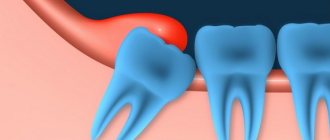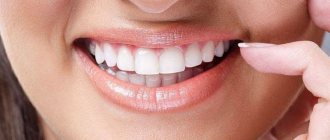Photopolymers for teeth are an innovative achievement in the field of dentistry. A new method appeared relatively recently and quickly became popular due to the low price of photopolymer dental restoration with a large number of advantages. With the help of photopolymers, tooth restoration is carried out in case of various damage to the enamel, the presence of cracks or incorrect location, for color correction, for filling or partial restoration of the shape of the tooth. Sign up for a consultation with specialists at the Omnident clinic in Moscow, and we will restore the beauty and health of your teeth using photopolymer materials.
Methods for restoring teeth
In the arsenal of modern dentistry there are various professional methods for restoring teeth. The dentist will determine which one will be used after the examination, and a method will be selected for each patient of our Dentistry and Aesthetics Center individually and at an affordable price, taking into account the wishes of the patient himself and the degree of destruction of the unit.
Methods for restoring teeth
:
- pin;
- photosensitive cement;
- fiberglass;
- vinyl;
- microprosthetic inlays.
Clinical example
:
Before | After |
Teeth extension
If 20 years ago dentists solved such problems as deep caries, injuries, chips or age-related wear of teeth using a radical method, installing a rough filling, removing the remaining stump or installing expensive dentures, today, thanks to the extension of the frontal/masticatory units, you can easily get your tooth back , even if only its root or stump remains.
When building up, the material is selected in such a way that it completely imitates the anatomical features of bone tissue and matches it both in strength, texture and shade.
Before | After |
Restoration with photopolymers (composite materials)
Photopolymers
– these are light-curing liquid composite materials, which consist of an organic matrix and filler, hardening under the influence of ultraviolet radiation. The quality of these materials will depend on the size and amount of filler used. For example, to restore the integrity of a tooth, hybrid composites with small particles are used, and large ones are used for filling.
Effective restoration of enamel with photopolymer materials today is one of the most reliable and aesthetic areas in dentistry. Using photopolymers, you can either install a high-quality filling, cure caries, or, if part of a tooth is missing, restore its shape to its original state. But modeling with photopolymers is only possible if tooth tissue is present.
Photopolymers are used if it is necessary to restore
:
- size, shape or color of the tooth;
- enamel when darkening;
- the entire crown, but only the root remains;
- tooth if chips or cracks occur.
Photopolymers are also used for tooth mobility or if there is a need to straighten the dentition.
Photopolymer filling (or as it is also called light filling) is not only very durable, but also has excellent aesthetic qualities. This type of composite reproduces the shape of the crown, and the filling can be given the desired natural color.
Prosthetics using photopolymers
Large fillings are called microprostheses; they help restore the complete appearance of a damaged tooth.
If the dental crown is destroyed, but the root remains, you can insert a special pin and build up photocomposite material on it. A small miracle occurs: a man-made dental crown is born. For such direct reconstruction as tooth augmentation with photopolymer, the price will be lower than for indirect prosthetics.
Restoring teeth with fiberglass
Restoration using fiberglass technology helps eliminate various imperfections and defects of teeth and preserve their beauty.
Before | After |
Fiberglass has high aesthetics and is a modern, reliable, absolutely safe and very durable material, thanks to which new teeth not only look natural against healthy ones, but also become stronger. The fact that fiberglass does not stain or change its original color throughout its entire service life indicates that this material is high-quality and indispensable in restoring dental health.
Fiberglass is widely used in carrying out
:
- splinting mobile teeth;
- dental recession during post-orthopedic treatment;
- restoration of special prostheses.
In addition, the advantage of restoring teeth with fiberglass is that it is a gentle method, since there is no need to depulpate the supporting teeth and in one visit to the doctor you can restore all the teeth directly in the oral cavity.
Restoration of anterior teeth before and after photos
However, each medical procedure has its own contraindications and limitations that the patient needs to be aware of.
Pin restoration
If the tooth is severely damaged and its root is also damaged, then pin restoration can help. This method allows, in case of severe destruction of a front tooth or molar, to restore and return it to its previous shape by building it onto a pin.
Pins are used not only to restore a tooth and correct a bite, but also to be able to attach a prosthesis or crown to the root. Pin restoration is even equated to artistic restoration.
When are photopolymers used?
When are photopolymers used?
Using light-curing composites, teeth can be restored in the following way:
- adjust shape, length, shade;
- strengthen loose teeth;
- build a tooth onto the root;
- using an adhesive bridge to recreate a lost tooth.
Indications for photopolymer filling are mechanical trauma to the tooth, pulpitis, caries, periodontitis (inflammation of the peri-root tissues). Light composites prevent further tooth destruction, but do not eliminate inflammation in the roots or perforation. Also, light composites will not help with a critical degree of loosening of the dentition.
Microprosthetics with inlays
Modern dentistry, instead of conventional tooth filling, offers the option of restoring teeth using microprosthetics with inlays. This method allows you to restore and preserve a large part of the tooth.
Inlays for microprosthetics are made of various materials - ceramics, zirconium, gold or cobalt-chrome.
It is worth noting that the inlays last an order of magnitude longer than conventional fillings due to their denser structure than that of filling materials and the tightest fit of the inlays to the tooth tissue. The latter quality allows you to avoid the risk of recurrent caries and inflammatory processes.
During microprosthetics, a ready-made inlay (microinsert) is installed in the cavity of a living tooth, which will ensure the restoration of the coronal part, even if no more than a third of it remains.
Whatever method is chosen, the success of the result will depend both on the quality of the materials used and the professionalism of the dentists.
Dr. Razumenko’s dental clinic in Moscow employs not just highly qualified dentists, but professionals with extensive experience who restore teeth using modern computer technology, the latest precision equipment and proven materials. The careful and high-quality work of our specialists will not only restore your teeth, but also make them even more beautiful and stronger.
Methods
The process of restoring the front teeth is carried out using one of the existing methods, which is selected individually by a specialist.
The composite material is fixed directly into the cavity or an inlay is first made, which is then attached to the adhesive composition:
- Direct reconstruction involves applying a filling compound to the prepared area in accordance with the technology and rules for using the selected material.
- Indirect restoration involves the use of inlays that are made outside the patient’s mouth in a laboratory setting. Fixation is carried out in the damaged area using special cement.
In order to determine the most suitable restoration method, the specialist evaluates the extent of the damaged area, the bite and other characteristics of the patient.
Without a preliminary examination and elimination of the consequences of caries or other types of lesions, no specialist will choose a method and material.
Mistakes made at the preparatory stage negatively affect the service life of fillings and inserts, so there is no need to speed up the restoration process.
In addition, they are incredibly durable, subject to a negligible percentage of abrasion, and have low polymerization shrinkage.
Indications and contraindications
Indications
:
The goals of the procedure are to restore the color, shape, and functionality of the tooth. Restoration eliminates crown chips, cracks and irregularities, fragments of destroyed tissue, damage/thinning of enamel, manifestations of a wedge-shaped defect, caries:
- correction of aesthetic indicators;
- treatment of lesions and inflammations of non-carious/carious origin with complete regeneration of the organ’s performance indicators: production of an artificial unit/bridge in the laboratory, filling of carious cavities.
Contraindications
:
The intervention is not carried out if there is a pacemaker, an allergy to restoration materials, or the impossibility of completely isolating the organ/oral cavity from moisture. If a patient is diagnosed with severe symptoms of bruxism, pathological bite, or increased abrasion, a preliminary consultation with a neurologist, psychologist, or dental therapist is required.
Prices for aesthetic dental restoration
The price of services for artistic modeling and restoration of teeth in Moscow and the Moscow region is competitive, since we purchase materials directly from the manufacturer. We use raw materials with a special set of properties and operating principles.
| Service | Price |
| Consultation + treatment plan | For free |
| Aesthetic restoration | From 12,100 ₽ |
| Ceramic veneers for teeth | 33 750 ₽ |
| Recovery tab (E-max material) | 23 300 ₽ |
| Composite tab | 9 140 ₽ |
*For detailed information about services, prices, as well as additional discounts, please contact our specialists!
A snow-white smile is a reality! Remember, no matter how diligently you take care of your oral cavity, over time the enamel will lose its attractiveness, because many drinks and foods provoke darkening. Rid yourself of complexes, chips, curvature and other defects right now by contacting Novadent.
Expert of the article you are reading: Poilov Denis Nikolaevich Orthopedist, leading specialist of the NovaDent network
13 years
Clinical experience
Petrovsko-Razumovskaya
Verkhniye Likhobory
st. Dubninskaya, 27, building 1
+7
Free consultation with this specialist
Stages of dental restoration
1.
Treatment planning.
At the initial appointment, a visual and instrumental examination and analysis of the oral cavity are performed. The topographic position of the elements of the dental arch, the shape of the vestibular surface, the cutting edge/dental contour, the length of contacts between units of the row, and individual characteristics are determined. After diagnostics, the optimal shade of the material is selected to recreate transparency/natural shine;
2.
Sanitation
. During preparation, hygienic cleaning, removal of stone/plaque, and treatment of diseases are performed: filling carious cavities using local anesthesia;
3.
Fixation of the pin in the root canal
. The pin is fixed in case of significant loss of tooth tissue; in the future, the rod structure serves as the basis for the formation of a new organ;
4.
Regeneration of the unit shape with filling material
;
5.
Finishing
: polishing and grinding.
Preparation
To obtain a high-quality result, you need to carefully prepare the oral cavity for the restoration procedure.
- treatment of dentition with polishing paste (performed with special nylon brushes);
- selection of filling material according to color scheme;
- administration of an anesthetic drug (usually ultracaine or mepivacaine is used).
If necessary, the preparatory stage includes treatment. No specialist will undertake the restoration of damage without first eliminating dental problems.
Rules of care
Oral care after restoration involves following the rules of hygiene and the following recommendations:
- after the procedure, you should not eat foods containing dyes, drink coffee, or strong tea for 18-20 hours;
- avoid high loads, use soft brushes, non-aggressive pastes, gels with neutral PH;
- You should not use rinses that contain chlorhexidine - it can change the color of the restoration;
- patients with bruxism need to use special mouth guards to prevent chipping of orthopedic structures;
- adjust your diet: avoid eating nuts, hard vegetables/fruits, colored carbonated drinks, beets, quit smoking and alcohol, too cold/hot food, which can cause chips and cracks in the material and loss of its snow-white color.
If external changes, increased sensitivity and pain occur, you should immediately contact your dentist to eliminate serious complications. For the purpose of prevention, it is necessary to visit a doctor twice a year.
Our prices
To find out the cost of complete restoration of hard dental tissues, schedule a consultation with our dentistry by calling.
| Code no. | Name of procedures | Unit of measurement | Cost, rub. |
| 303 | Treatment of medium caries (ultrasound, cavity formation) | 700,00 | |
| 305 | Placement of a light-composite filling (Esthet-X, Filtek) | 3 500,00 | |
| 312 | Veneer coating with repositioning of teeth (complex) | 1 unit | 9 500,00 |
| 314 | Artistic restoration (changes in shape and position) complex | 1 unit | 13 000,00 |
| 317 | Tooth restoration using a fiberglass pin and reinforced composite material (Sonicfil, Luxocor) | 5 500,00 |
* The prices indicated on the website are not a public offer. The exact cost of treatment can only be determined at an appointment with a doctor.
Prices for treatment in Moscow full price list
Share on social media networks:
Article Expert:
Razumenko Evgeniy Gennadievich
Chief physician and founder of the dental clinic. He has been working in aesthetic dentistry for many years, restoring teeth of any complexity with ceramic and composite restorations. Winner of competitions in aesthetic dentistry. Applies CAD/CAM technologies in prosthetics.
Work experience 22 years
Photopolymer restoration: features
Light-curing materials in dentistry have a high coefficient of adhesion, practically do not shrink and can withstand heavy loads. Therefore, dental restoration with photopolymers is suitable for almost all teeth. Dentists perform:
- Photopolymer restoration of anterior teeth;
- Teeth extension with photopolymers;
- Filling of chewing and front teeth with photopolymers.
In recent years, a new photopolymer has been developed that has a nanohybrid structure. Fillings made from this composition have a high strength coefficient, and at the same time they are plastic. Thus, restoration of anterior teeth with photopolymer can be implemented even on microscopic cavities, where traditional material cannot hold.
Another advantage of the new method: during installation of a light-curing filling, only the top layers damaged by caries are removed from the tooth. That is, there is no need to drill and injure the tissue once again.
Large fillings are called microprostheses; they correct the appearance, while it is possible to form any shape of the tooth.
Photopolymer dental restoration helps solve many problems of the oral cavity, which is why it is actively developing and is very popular in recent years. At the same time, the price of photopolymer for teeth remains in the average marketing segment. We follow the development of the industry and offer our clients the latest technologies and materials in the dental market. With us you will receive modern treatment at the highest level.
We recommend that you read
Bite correction
Adhesive microprosthetics
Dental restoration
Teeth whitening










